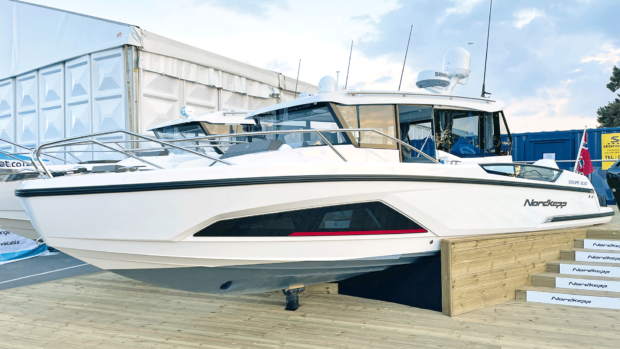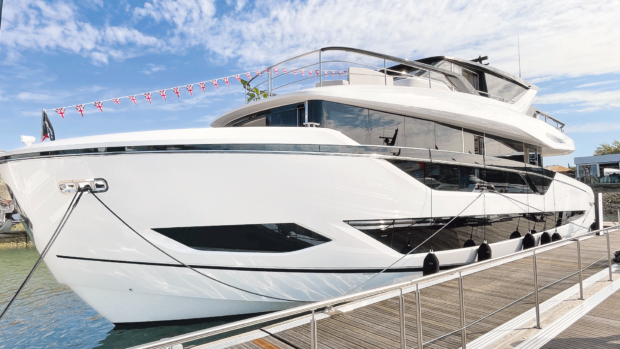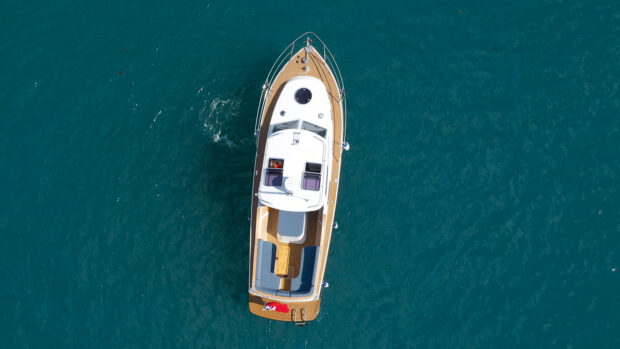Small boat enthusiast and keen kayaker Andrew Morton embarks on a 300nm journey to the remote Outer Hebridean island of St Kilda in his 25ft Finnmaster 76CA…
Author and local historian Charles Maclean described St Kilda as an island on the edge of the world. My parents knew his father, Sir Fitzroy, for more than 20 years so it had been on my list of places to visit for some time.
The opportunity finally arose last summer, towards the end of June, when a settled spell of weather appeared in the forecast. My boat is normally moored at Largs, so I was looking at a distance of almost 300nm, a fair bit of which was crossing open ocean.
While such a journey would be no big deal in a 50ft trawler yacht, Tiptoe is a 25ft Finnmaster 76CA pocket cruiser with a single 225hp Volvo Penta diesel engine, so venturing that far offshore is undoubtedly a challenge but it’s one that I relish.
Back in 2019 I took her to Shetland, and here was an opportunity to ‘bag’ another remote and fascinating island. The key to success is planning, and that includes picking the right weather.
As you will see from the summary log below, wind was not a problem for me during the seven days it took me to get from Largs to St Kilda and back to Craobh Haven, a beautiful marina just south of Oban where I often stay for extended periods. If you haven’t been there, it’s a must.
Article continues below…

Cruising to the Shetland Islands: Open ocean adventure in a 25ft motorboat

Cruising Scotland: A self-indulgent summer exploring the Inner Hebrides by boat
I took my kayak with me, as I always do. It adds so much to the experience for two simple reasons: firstly, it enables me to explore inaccessible parts of the coastline where my own boat simply can’t go, and secondly, it keeps me fit.
Besides, the yachties tend to look down on our “press-and-go” and “non-green” mentality, so we owe it to the motor boating community to fight back on every front! To be honest, there’s nothing to beat West Coast Scotland cruising, so long as the weather is good – and that’s the catch of course.
Despite my chosen dates being very close to mid-summer, the air temperature was sometimes lower than London in mid-winter. That’s something to bear in mind for sure. But a huge bonus is the length of each day. At the end of June, sunrise in the Outer Hebrides is at 04.30 and sunset at 22.30, so it never really gets dark.

Andrew’s Finnmaster 67CA Tiptoe
That means daylight cruising time and range are extended considerably, which is particularly useful for long trips and gives more flexibility when timing departures to catch the tide. The wind is often less strong early in the morning too, making early starts a real pleasure.
I took advantage of this on several occasions, including one particularly memorable four-mile crossing from Hirta, the main island of the St Kilda archipelago, to Boreray as the sun rose over the horizon.
Mind you, it doesn’t always work in your favour as was the case when I departed Colonsay in the mist and crossed the open ocean to Berneray and Mingulay – all the time in poor visibility.

A misty arrival at Village Bay, Hirta
The highlight of the trip was visiting both St Kilda and the Monach Isles in remarkably good weather. Both are hugely contrasting archipelagos – one the craggy remains of an ancient volcano and the other low-lying sandy atolls.
The snag with Hirta is that there is really only one decent sheltered bay, and it’s open to the prevailing south-westerly winds. So that very much limits the weather in which you
can approach and stay at the island.
As it happened, the wind died and the sun came out on the afternoon of my arrival, which allowed me to kayak round the island, go ashore in the evening to explore, and stay the night.

Tiptoe has only one engine and is ten years old with 1,300 hours on the clock. Despite this I don’t carry an auxiliary outboard engine. It was a considered decision not to buy one, which I made based on the following six reasons:
- The cost – I’m a Scot after all!
- The engine takes up space on the stern of the boat, which I need to launch my kayak and tender, and for less nimble passengers to gain access
- The engine and fuel add substantial weight to the boat
- The fuel is petrol, which I’d rather not carry
- The likelihood of requiring this backup is very low
- I’ve got many other systems to help me in distress, including VHF radio, personal locator beacon, tender and lightweight spare, two anchors (each with chain and a combined length of 80m), sea anchor, mobile phone and a regular donation to the RNLI!
So far my decision has served me well. Had I bought an outboard at the outset, I would have been carrying it, plus a can of petrol, with me for ten years, to no avail. Bear in mind that many larger commercial boats only have one engine too and no backup, so I’m not alone in my decision.
It’s true that in an ideal world I’d like a boat with two completely separate engines, but I’m comfortable enough running with one, which is much more economical, of course.

Andrew’s kayak on one of the deserted beaches in the Monach isles
Calculated risk
Does it bother me? Yes, just a little. On my trips to both Shetland and St Kilda, there were moments when the lack of backup crossed my mind. It’s a risk, but we all take risks and we weigh up the pros and cons. Driving to the boat in my car is a risk, as is climbing the stairs in my house.
The key is to mitigate it as best you can. I also have my ocean kayak with me, in which I can sustain 5 knots for over three hours. That said it’s impossible to get into my kayak off the bathing platform if it’s anything other than calm so that’s a no-no. And why leave the boat, unless it’s sinking?

A racing kayak is certainly an unconventional tender
All this was part of the adventure of course: setting off solo from Largs, with the aim of reaching St Kilda, was a real thrill. Loaded up with fuel, food and drink, a kayak on the roof and a folding bike below, I was all set to explore the islands of Scotland. And I would be doing so almost entirely alone, miles from civilisation.
Thankfully, Tiptoe has all the mod cons: fridge, cooker, separate toilet and hot shower, three berths, two heaters, auto-pilot with remote, bow thruster and electric anchor winch. It’s a small but perfectly formed cruising package.
Intriguing isles
What of the islands themselves? The last inhabitants left St Kilda in 1930 but there is much evidence of their presence still to see. The most remarkable being the hundreds of cleits scattered over Hirta, like currants on a cake.

A well-preserved cleit (bothy) in Hirta, St Kilda
These small stone huts were built to store and dry food – sea birds in particular – including puffins, gannets and fulmars. The other notable feature was the presence of the military.
St Kilda occupies a key spot in the Atlantic, very useful for keeping an eye on passing trade – friend and foe. So there was much activity, which rather spoils the experience of exploring a remote island.
However, the reception from all was friendly and much appreciated. The highlight of my visit was paddling round Hirta in my kayak, a distance of just over 8 miles, which I did in an hour and a half.

Stac Lee Soay surrounded by gannets with Hirta in the distance
After a bite to eat on Tiptoe to recharge the batteries, I went ashore again in my dinghy and walked to the top of Mullach Bi, to take pictures as the sun set over the Atlantic. The climb of 1,000 feet is steep but an absolute must if the weather is clear.
On returning to my boat, the National Trust RIB came by. Word had got round that I had paddled round the island rather quickly and one of the young men on the RIB shouted across, “Do you remember me Mr Morton? You taught me Biology at Dollar Academy many years ago.” Well, I did remember him, and returned his compliments.
He’s now the RSPB warden so some passion for the birds and bees must have rubbed off at some point in his education. What a small world it is. As the weather had improved so much, I elected to stay the night at anchor in Village Bay.

A perfect evening anchorage for Andrew’s valiant Finnmaster 76CA
The following morning was glorious and I took Tiptoe across to Boreray, just four miles from Hirta. There wasn’t a soul about, of course, which added to the experience, just the feral Soay sheep and thousands of sea birds.
The ancient volcanic island rises straight out of the ocean, so you can bring the boat up to the rocks within touching distance. How the St Kildans managed to go ashore and stay for days to catch birds stretches the imagination.

Some of the many caves pockmarking Boreray’s coastline
I have to say, the gentle cruise round the island in the morning sun and calm seas, miles from the mainland, was an experience I will never forget. On then to the Monach Isles, totally different in so many respects. They are not volcanic, and not too long ago in Geological time, they were attached to the mainland of the Hebrides and inhabited.
What a contrast, paddling round the shallow sandy bays in my kayak in the warm sun. Again, totally solo – not a soul to be seen. It was such a privilege to be able to visit these remote spots, explore the deserted beaches of Monach and the caves of St Kilda, and enjoy these islands in all their glory and desolate splendour.
And the trip back from Monach Isles to Craobh Haven? Quick and easy, and mercifully trouble free. Thanks again Tiptoe.

Back at Craobh Haven after a calm, trouble-free crossing
| Mini Log of trip to St Kilda and Monach Isles [M = Marina A = Anchor] | |||||
|---|---|---|---|---|---|
| Date | Leave | Arrive | Distance (nm) | Fuel (Litres) used | Wind (Force) cloud |
| 29/6 | Largs (M) | Lamlash(A) | 17 | 11 | 0-4 – 20% |
| Left Largs 16.00 to get tide behind me all the way to Arran. 240 litres of fuel on board. A bit breezy. | |||||
| 30/6 | Lamlash | Oronsay(A) | 90 | 56 | 0 – 90% |
| Left early in the morning, and stopped at Port Ellen en route. Took on 20 litres of fuel from local garage. | |||||
| 01/7 | Oronsay | Eriskay(A) | 100 | 87 | 0 – 100% |
| Left early morning in mist, and stopped at Castlebay, Barra, to pick up 130 litres | |||||
| 02/7 | Eriskay | St Kilda(A) | 64 | 50 | 1-2 – 90% |
| Across open ocean to St Kilda. Kayaked round Hirta and spent some time ashore in the evening. | |||||
| 03/7 | St Kilda | Loch Maddy (M) | 82 | 71 | 0 – 50% |
| Stopped at Monach Islands after leaving St Kilda and paddled around the archipelago. | |||||
| 04/7 | Loch Maddy | Loch Boisdale (M) | 40 | 32 | 1 – 30% |
| Picked up 20 litres of fuel and joined a friend for dinner ashore. | |||||
| 05/7 | Loch Boisdale | Craobh Haven (M) | 87 | 83 | 0 – 80% |
| Was able to cross the Minch at over 20 knots in near flat-calm conditions. Stopped at Tobermory for a bite to eat and 50 litres of fuel |
|||||
| TOTALS | 480 | 390 | |||
| 1.23 miles/litre or 3.7 gallons/hour. Average speed 9.5 knots | |||||

Tiptoe moored at Lochboisdale, Uist

No shallows whatsoever around the island of Boreray

A hauntingly beautiful morning departure from Boreray island

Graveyard on Hirta










